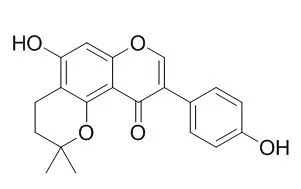| In vitro: |
| Pakistan Journal of Biological Sciences, 2011, 14(10):560-571. | | Assessing Sub-saharian Erythrina for Efficacy: Traditional uses, Biological Activities and Phytochemistry.[Reference: WebLink] |
METHODS AND RESULTS:
The genus Erythrina comprises more than 100 species, widely distributed in tropical and subtropical areas. In Africa, 31 wild species and 14 cultivated species have been described. In sub-Saharan Africa, Erythrina species are used to treat frequent parasitic and microbial diseases, inflammation, cancer, wounds. The rationale of these traditional uses in African traditional medicine was established by screening several species for biological activities. Promising activities were found against bacteria, parasites (Plasmodium), human and phytopathogenic fungi, some of which were multidrug resistant (MDR) micro organisms. Some species also exhibited antioxidant, anti-inflammatory activities and enzymes inhibitory properties. Most of the species chemically investigated were reported to contain flavanones, prenylated isoflavones, isoflavanones(alpha-Isowighteone
) and pterocarpans. Some phytochemicals (vogelin B, vogelin C, isowightcone, abyssinin II, derrone) were the active principles as antibacterials, antifungals, antiplasmodials and inhibitors of enzyme borne diseases (PTP1B, HIV protease, DGAT).
CONCLUSIONS:
This review highlights the important role of Erythrina species as sources of lead compounds or new class of phytotherapeutic agents for fighting against major public health (MDR infections, cancer, diabetes, obesity) in sub-Saharan Africa. |
|






 Cell. 2018 Jan 11;172(1-2):249-261.e12. doi: 10.1016/j.cell.2017.12.019.IF=36.216(2019)
Cell. 2018 Jan 11;172(1-2):249-261.e12. doi: 10.1016/j.cell.2017.12.019.IF=36.216(2019) Cell Metab. 2020 Mar 3;31(3):534-548.e5. doi: 10.1016/j.cmet.2020.01.002.IF=22.415(2019)
Cell Metab. 2020 Mar 3;31(3):534-548.e5. doi: 10.1016/j.cmet.2020.01.002.IF=22.415(2019) Mol Cell. 2017 Nov 16;68(4):673-685.e6. doi: 10.1016/j.molcel.2017.10.022.IF=14.548(2019)
Mol Cell. 2017 Nov 16;68(4):673-685.e6. doi: 10.1016/j.molcel.2017.10.022.IF=14.548(2019)